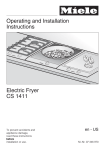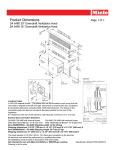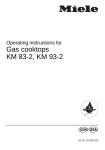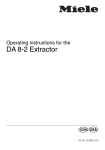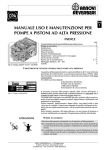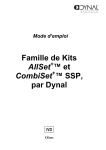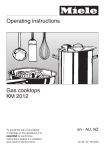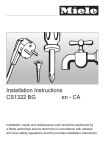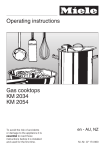Download Miele CSZL 400 hob
Transcript
Installation instructions Gas-hob KM 404 / KM 405 KM 406 KM 414 / KM 417 It is essential to read these instructions before installing or using the machine, to avoid the risk of accident or damage to the machine. WO M.-Nr. 05 021 252 Contents Warning and Safety instructions . . . . . . . . . . . . . . . . . . . . . . . . . . . . . . . . . . . . . 4 Building in . . . . . . . . . . . . . . . . . . . . . . . . . . . . . . . . . . . . . . . . . . . . . . . . . . . . . . . . 4 Appliance dimensions . . . . . . . . . . . . . . . . . . . . . . . . . . . . . . . . . . . . . . . . . . . . . . 6 KM 404. . . . . . . . . . . . . . . . . . . . . . . . . . . . . . . . . . . . . . . . . . . . . . . . . . . . . . . . . . . 6 KM 405. . . . . . . . . . . . . . . . . . . . . . . . . . . . . . . . . . . . . . . . . . . . . . . . . . . . . . . . . . . 7 KM 406. . . . . . . . . . . . . . . . . . . . . . . . . . . . . . . . . . . . . . . . . . . . . . . . . . . . . . . . . . . 8 KM 414. . . . . . . . . . . . . . . . . . . . . . . . . . . . . . . . . . . . . . . . . . . . . . . . . . . . . . . . . . . 9 KM 417. . . . . . . . . . . . . . . . . . . . . . . . . . . . . . . . . . . . . . . . . . . . . . . . . . . . . . . . . . 10 Safety clearance. . . . . . . . . . . . . . . . . . . . . . . . . . . . . . . . . . . . . . . . . . . . . . . . . . 11 KM 404 / KM 405 / KM 406 . . . . . . . . . . . . . . . . . . . . . . . . . . . . . . . . . . . . . . . . . . 11 KM 414 / KM 417 . . . . . . . . . . . . . . . . . . . . . . . . . . . . . . . . . . . . . . . . . . . . . . . . . . 11 Worktop cut-out for KM 404 / KM 405 / KM 406 . . . . . . . . . . . . . . . . . . . . . . . . . 13 Installation KM 404 / KM 405 / KM 406 . . . . . . . . . . . . . . . . . . . . . . . . . . . . . . . . 14 Fitting the spacer bars and support brackets . . . . . . . . . . . . . . . . . . . . . . . . . . . . 14 Fixing the spacer bar . . . . . . . . . . . . . . . . . . . . . . . . . . . . . . . . . . . . . . . . . . . . . . . 15 Granite worktops. . . . . . . . . . . . . . . . . . . . . . . . . . . . . . . . . . . . . . . . . . . . . . . . 15 Fixing the support brackets . . . . . . . . . . . . . . . . . . . . . . . . . . . . . . . . . . . . . . . . . . 16 Granite worktops. . . . . . . . . . . . . . . . . . . . . . . . . . . . . . . . . . . . . . . . . . . . . . . . 16 Building in the gas hob . . . . . . . . . . . . . . . . . . . . . . . . . . . . . . . . . . . . . . . . . . . . . 16 Worktop cut-out KM 414 . . . . . . . . . . . . . . . . . . . . . . . . . . . . . . . . . . . . . . . . . . . 17 Installation KM 414 / KM 417 . . . . . . . . . . . . . . . . . . . . . . . . . . . . . . . . . . . . . . . . 18 Fitting the spacer bars and support brackets . . . . . . . . . . . . . . . . . . . . . . . . . . . 18 Fixing the spacer bar . . . . . . . . . . . . . . . . . . . . . . . . . . . . . . . . . . . . . . . . . . . . . . 19 Fixing the support brackets . . . . . . . . . . . . . . . . . . . . . . . . . . . . . . . . . . . . . . . . . . 20 Granite worktops. . . . . . . . . . . . . . . . . . . . . . . . . . . . . . . . . . . . . . . . . . . . . . . . 20 Building in the gas hob . . . . . . . . . . . . . . . . . . . . . . . . . . . . . . . . . . . . . . . . . . . . . 20 2 Contents General . . . . . . . . . . . . . . . . . . . . . . . . . . . . . . . . . . . . . . . . . . . . . . . . . . . . . . . . . 21 Electrical connection . . . . . . . . . . . . . . . . . . . . . . . . . . . . . . . . . . . . . . . . . . . . . 22 Gas connection . . . . . . . . . . . . . . . . . . . . . . . . . . . . . . . . . . . . . . . . . . . . . . . . . 23 Natural gas / liquid gas . . . . . . . . . . . . . . . . . . . . . . . . . . . . . . . . . . . . . . . . . . . . . 24 Conversion to another type of gas . . . . . . . . . . . . . . . . . . . . . . . . . . . . . . . . . . . 25 KM 404. . . . . . . . . . . . . . . . . . . . . . . . . . . . . . . . . . . . . . . . . . . . . . . . . . . . . . . . . . 25 Jet table . . . . . . . . . . . . . . . . . . . . . . . . . . . . . . . . . . . . . . . . . . . . . . . . . . . . . . 25 Changing the jets . . . . . . . . . . . . . . . . . . . . . . . . . . . . . . . . . . . . . . . . . . . . . . . 26 KM 405. . . . . . . . . . . . . . . . . . . . . . . . . . . . . . . . . . . . . . . . . . . . . . . . . . . . . . . . . . 27 Jet table . . . . . . . . . . . . . . . . . . . . . . . . . . . . . . . . . . . . . . . . . . . . . . . . . . . . . . 27 Changing the jets . . . . . . . . . . . . . . . . . . . . . . . . . . . . . . . . . . . . . . . . . . . . . . . 28 KM 406. . . . . . . . . . . . . . . . . . . . . . . . . . . . . . . . . . . . . . . . . . . . . . . . . . . . . . . . . . 29 Jet table . . . . . . . . . . . . . . . . . . . . . . . . . . . . . . . . . . . . . . . . . . . . . . . . . . . . . . 29 Changing the jets . . . . . . . . . . . . . . . . . . . . . . . . . . . . . . . . . . . . . . . . . . . . . . . 30 Check the first intake of air . . . . . . . . . . . . . . . . . . . . . . . . . . . . . . . . . . . . . . . . 33 KM 414 . . . . . . . . . . . . . . . . . . . . . . . . . . . . . . . . . . . . . . . . . . . . . . . . . . . . . . . . . 34 Jet table . . . . . . . . . . . . . . . . . . . . . . . . . . . . . . . . . . . . . . . . . . . . . . . . . . . . . . 34 Changing the jets . . . . . . . . . . . . . . . . . . . . . . . . . . . . . . . . . . . . . . . . . . . . . . . 35 KM 417. . . . . . . . . . . . . . . . . . . . . . . . . . . . . . . . . . . . . . . . . . . . . . . . . . . . . . . . . . 36 Jet table . . . . . . . . . . . . . . . . . . . . . . . . . . . . . . . . . . . . . . . . . . . . . . . . . . . . . . 36 Changing the jets . . . . . . . . . . . . . . . . . . . . . . . . . . . . . . . . . . . . . . . . . . . . . . . 37 3 Warning and Safety instructions Building in Fit wall units and the cooker hood before fitting the appliance, to avoid damaging it. As a minimum 20 m3 space is required where the appliance is installed, and a door or window which can be opened to the outside air. The veneer or laminate coatings of worktops (or adjacent kitchen units) must be treated with 100 °C heat resistant adhesive which will not dissolve or distort. The worktop upstand must be heat resistant. recommended Ideally the hobs should be installed with plenty of space on either side. There may by a wall at the rear and a wall or tall units at one side. On the other side, however, no unit or divider should stand higher than the hob. Due to the heat radiated by the hob and to allow cooking fumes to dissipate it is essential that a minimum safety distance a is maintained between the worktop cut-out and adjacent kitchen units, e.g. a tall unit, as follows: 100 mm with KM 404 / KM 405 250 mm with KM 406 200 mm with KM 414 / KM 417 There must be a minimum safety distance of 50 mm between the appliance and a back wall. not recommended not allowed 4 Warning and Safety instructions The gas hob must not be installed next to an electric fryer, as the gas flames could ignite fat in the fryer. It is essential to maintain a minimum distance of 288 mm between these two appliances. Safety distance above appliances A hob may not be built in over a washing machine, tumble dryer, dishwasher, fridge, fridge-freezer or freezer. The high radiant temperatures which are sometimes generated by the hob could damage such appliances. This equipment is not designed for maritime use or for use in mobile installations such as caravans, aircraft etc. However it may be suitable for such usage subject to a risk assessment of the installation being carried out by a suitably qualified engineer. A minimum safety distance b must be maintained between the hob and the cooker hood above it. See the manufacturer’s operating and installation instructions for details. For any flammable objects, e.g utensil rails, wall units etc. a minimum safety distance of at least 760 mm should be maintained between it and the hob below. When two or more appliances are installed together below a cooker hood, e.g. a ceramic combiset and a gas wok combiset, which have different safety distances given in their installation instructions you should select the greater distance of the two. All dimensions in this instruction booklet are given in mm. Keep these instructions in a safe place and pass them on to any future owner of the appliance. 5 Appliance dimensions KM 404 a Support bracket b Building in height plus 3 mm for fixing screw 6 Appliance dimensions KM 405 d 288 514 8 55 b min. 50 max.R4 500 a 6 26 c c b 8 58 48 55 514 d e 72 30 25 8 28 a Support bracket b Building in height plus 3 mm for fixing screw c Front d Building in height - Mains connection box e Gas connection 7 Appliance dimensions KM 406 a Support bracket b Building in height plus 3 mm for fixing screw 8 Appliance dimensions KM 414 a Support bracket b Building in height plus 3 mm for fixing screw 9 Appliance dimensions KM 417 d 514 574 55 8 b a min. a 50 500 max.R4 60 2-5 55 c c 8 b 58 48 55 28 514 a Support bracket b Building in height plus 3 mm for fixing screw c Front d Building in height - Mains connection box e Gas connection 10 d e 6 25 72 4 57 Safety clearance Before installing the appliance check that the location provides the required clearances from combustible materials and if necessary provide protection to adjacent surfaces as required by regulations. Shown area indicates protected surface, which may be ceramic tiles or other approved material. If clearance between side and rear walls and the periphery of the burner is less than 200 mm, the walls must be protected with a non-combustible material. The protection must be extended a minimum distance of 150 mm above the burner (refer - gas fitting regulations). KM 404 / KM 405 / KM 406 KM 414 / KM 417 11 Safety clearance Clearance above and around the appliance a Range hood b not less than 650 mm from burner to any horizontal surface over full width of the appliance. c Burner d 10 mm recommended minimum e Combustible work bench f Regulator (NG) g test nipple of regulator 7 mm diam. 12 Worktop cut-out for KM 404 / KM 405 / KM 406 Installing one or more appliances Cut out the worktop according to the dimensions listed in the following chart. Worktop cut-out Depth in Number mm of ± 1 mm appliances Dimensions 7 mm and 11 mm are the space taken up by the frame of the appliance on the worktop. ^ Make a cut-out for the hob in the worktop, paying attention to the appliance height. See section "Appliance dimensions". Dimension "B" applies to a combination of appliances and is shown on the chart. There must be a minimum safety distance of 50 mm between the hob and the back wall and 100 mm distance from a side wall to the right or left of the hob (250 mm with KM 406). See also chapter "Warning and Safety instructions". ^ Seal the cut surfaces with a suitable sealant to avoid swelling caused by moisture. The materials used must be heat resistant. Width (= Dim. B) in mm ± 1 mm 1 500 266 mm 2 500 554 mm 3 500 842 mm 4 500 1130 mm 5 500 1418 mm 6 500 1706 mm 7 500 1994 mm Important: The maximum tolerance for the worktop cut-out must not exceed ± 1 mm. When building in several combiset appliances a spacer bar must be fitted between each unit. See chapter "Fitting the spacer bars and support brackets". 13 Installation KM 404 / KM 405 / KM 406 Fitting the spacer bars and support brackets a Support brackets b Spacer bars c Gap between spacer bar and worktop. d Drilling for a granite worktop. The illustration above shows an example of a worktop cut-out with spacer bars b and support brackets a for 3 appliances. For more than 3 appliances, repeat dimension 288 mm. The worktop cut-out dimensions for several appliances are shown in the table on the previous page. 14 ^ Fix the spacer bars b and the support brackets a supplied to the positions indicated. See chapter "Fixing the spacer bars" and "Fixing the support brackets". For the installation of electric appliances see respective installation instructions. Installation KM 404 / KM 405 / KM 406 Fixing the spacer bar d Granite worktops ^ With granite worktops the spacer bars b must be positioned and secured with strong double-sided adhesive tape. In addition, coat the edges with silicone and fill in gap c. The screws are not required for granite worktops. c ^ Position the spacer bars b in the positions shown in "Fitting the spacer bars and support brackets" so they are flush with the top edge of the cut-out, and secure with the 3.5 x 25 mm screws supplied. ^ Then fill in gap c between the bars and the worktop with silicone from the tube supplied. 15 Installation KM 404 / KM 405 / KM 406 Fixing the support brackets Granite worktops On a granite worktop a hole must be drilled d at the position indicated to secure each support bracket. ^ Using a piece of strong, doublesided adhesive tape position the support brackets supplied a at the positions indicated flush with the top edge of the worktop and secure each bracket with one screw in hole d as shown. Building in the gas hob ^ Position the two support brackets supplied a in the positions shown in "Fitting the spacer bars and support brackets" so that they are flush with the top edge of the cut-out, and secure with the 3.5 x 25 mm screws supplied. 2 screws are needed to secure each support bracket. The thickness of the worktop will determine which drilled hole is used. Please note that height of the support bracket for the KM 406 is different to that for the KM 404 and KM 405. 16 ^ Lay the gas hob in the prepared cut-out. ^ Draw the electricity connection cable through the cut-out and connect. ^ Make the gas connection (see chapter "gas connection"). ^ Secure the gas hob from below through the middle elongated hole b in each support bracket using the two screws supplied. Carefully adjust the hob if necessary. Worktop cut-out KM 414 Worktop cut-out KM 414 / KM 417 Depth in mm ± 1 mm Width (= Dim B) in mm ± 1 mm 500 552-560 1 Hob Worktop cut-out KM 414 / KM 417 + 288 mm wide appliances Dimensions 7 mm and 11 mm are the space taken up by the frame of the appliance on the worktop. ^ Make a cut-out for the hob in the worktop. Dimension "B" applies to a combination of appliances and is shown on the chart. There must be a minimum safety distance of 50 mm between the hob and the back wall and 200 mm distance from a side wall to the right or left of the hob. See also chapter "Warning and safety instructions". ^ Seal the cut surfaces with a suitable sealant to avoid swelling caused by moisture. The materials used must be heat resistant. Depth in mm ± 1 mm Width (= Dim B) in mm ± 1 mm KM 414 / 417 +1 500 840 KM 414 / 417 + 2 500 1128 KM 414 / 417 + 3 500 1416 KM 414 / 417 + 4 500 1704 Number of appliances Important: The maximum tolerance for the worktop cut-out must not exceed ±1 mm. When building in several combiset appliances a spacer bar must be fitted between each unit. See chapter "Fitting spacer bars and support brackets". Narrow combiset appliances (288 mm wide) can be installed to the left or right hand side of the KM 414 / KM 417. 17 Installation KM 414 / KM 417 Fitting the spacer bars and support brackets KM 414 / KM 417with 2 appliances 288 mm wide b Support brackets 276 1128 431 e 0 e 50 KM 414 KM 417 bc d 563 d b c d e 288 d 133 e b 288 277 a Support brackets b Spacer bars c Gap between spacer bar and worktop. d Drilling for a granite worktop. Installation of several appliances The illustration above shows an example of a worktop cut-out with spacer bars b and support brackets a for 3 appliances. For more than 3 appliances, repeat dimension 288 mm. The worktop cut-out dimensions for several appliances are shown in the table on the previous page. 18 ^ Fix the spacer bars b and the support brackets a supplied to the positions indicated. See chapter "Fixing the spacer bars" and "Fixing the support brackets". For the installation of electric appliances see respective installation instructions. Installation KM 414 / KM 417 Fixing the spacer bar Granite worktops The spacer bar is only required when combined with a 288 mm wide combiset appliance. With granite worktops the spacer bars b must be positioned and secured with strong double-sided adhesive tape. In addition, coat the edges with silicone and fill in the gap c. d The screws are not required for granite tops. c ^ Position the spacer bars b in the positions shown in "Fitting the spacer bars and support brackets" so they are flush with the top edge of the cut-out and secure using the 3.5 x 25 mm screws supplied. ^ Then fill in the gap c between the bars and the worktop with silicone from the tube supplied. 19 Installation KM 414 / KM 417 Fixing the support brackets Granite worktops On a granite worktop a hole must be drilled d at the position indicated to secure each support bracket. ^ Using a piece of strong, doublesided adhesive tape position the support brackets supplied a at the positions indicated flush with the top edge of the worktop and secure each bracket with one screw in hole d as shown. ^ Position the two support brackets supplied a in the positions shown in "Fitting the spacer bars and support brackets" so they are flush with the top edge of the cut-out and secure using the 3.5 x 25 mm screws supplied. 2 screws are needed to secure each support bracket. The thickness of the worktop will determine which drill hole is used. 20 Building in the gas hob ^ Lay the gas hob in the prepared cut-out. ^ Draw the electricity connection cable through the cut-out and connect. ^ Make the gas connection (see chapter "gas connection"). ^ Secure the gas hob from below through the middle elongated hole b in each support bracket using the four screws supplied. Carefully adjust the hob if necessary. General Important Under no circumstances should sealant find its way between the frame of the top part of the hob and the worktop. This could cause difficulties if the hob ever needs to be taken out for servicing, (possibly leading to damage to the frame and worktop). The sealing strip under the edge of the top part of the hob provides a sufficient seal for the worktop. 21 Electrical connection Important All electrical work should be carried out by a suitably qualified and competent person in strict accordance with national and local safety regulations. For extra safety it is advisable to install a residual current device (RCD), with a trip current of 30 mA. Connection for each appliance should be made via a suitable isolator. The data plate gives the necessary data for connection. WARNING THIS APPLIANCE MUST BE EARTHED The wires in the mains lead are coloured in accordance with the following code: Green/yellow = earth Blue = neutral Brown = live As the colours of the wires in the mains lead of this appliance may not correspond with the coloured markings identifying the terminals in your plug proceed as follows: – The wire which is coloured green and yellow must be connected to the terminal in the plug which is marked with the letter E or by the earth symbol - or coloured green or green and yellow. – The wire which is coloured blue must be connected to the terminal which is marked with the letter N or coloured black. – The wire which is coloured brown must be connected to the terminal which is marked with the letter A or coloured red. 22 Gas connection Connection to the gas supply, or conversion from one type of gas to another should only be undertaken by an approved fitter, who is responsible for correct functioning of the appliance when installed. Every appliance should have its own isolating valve. Check with your local gas supplier about the type of gas and its calorific value, and compare this information with the type of gas quoted on the hob data plate. Connection Conversion to another type of gas is described under the relevant Section. The gas connection must be installed so that connection can be made either from inside or outside the kitchen unit, and the isolating valve must be easily accessible and visible (by opening one of the kitchen unit doors, if necessary). The gas hob is normally suitable for connection to either natural or liquid gas. Check suitability in your country with your dealer or agent. The hob is supplied ready for connection to natural gas. A set of jets for conversion to liquid gas is included with the hob. 23 Gas connection Natural gas / liquid gas The gas connection must be in accordance with national and local regulations. The relevant building regulations must also be observed. KM 404 / KM 405 / KM 406 The gas connection must be so sited that it is not adversely heated when the appliance is in operation. Pressure Test Point.This is provided on the gas regulator (supplied for natural gas). ^ Loosen the screw in the test point until it is free in its housing. The screw is retained in this position. ^ Connect the hose from the pressure gauge. ^ Reassemble one of the large burners, turn on the gas and manually light the burners. Gas pressure must be set by the approved gas fitter as shown on the data plate: KM 414 / KM 417 Natural gas 1.00 kPa ULPG (Propane/Butane) 2.75 kPa ^ Disconnect gauge and screw in the test point screw. When the gas hob has been installed it is essential to check that neither the gas pipe nor the electricity cable is in contact with hot parts of the appliance or hot gas exhaust. A full operational test and a test for possible leakages must be carried out by the fitter after installation. 24 Conversion to another type of gas KM 404 Jet table When converting to liquid gas, the main jets and the small jets of all burners must be changed. Nominal rating for all gas types with the burner full on Gas type MJ/h Normal burner NG ULPG 5.85 6.35 Fast burner NG ULPG 10.35 9.68 Total output NG ULPG 16.20 16.03 for AUS and NZ Main jet Ø low setting jet Ø NG Normal burner Fast burner 1.10 1.50 0.52 0.60 ULPG Normal burner Fast burner 0.70 0.87 0.32 0.40 The jet markings refer to 1/100 mm of the jet orifice. Nominal rating at low setting Gas type MJ/h Normal burner NG ULPG 1.04 1.00 Fast burner NG ULPG 1.70 1.65 Screw in the new jets according to the following table. 25 Conversion to another type of gas Changing the jets Changing the low setting jet Disconnect the gas hob from the electricity supply. Depending on the type of installation, either withdraw the mains fuse, switch off at the fused spur unit, or at the socket and withdraw the plug. Changing the main jets ^ Guide a screwdriver through the holes in the the lower casing of the hob and loosen the low setting jets f. ^ Pull the jets out with a pair of pointed pliers. ^ Put in the new jets with a pair of pointed pliers. ^ Secure the new jets with a screwdriver. ^ Finally secure the new jets against inadvertent loosening with sealing wax. ^ Take off the pan support, the burner cover b, the burner ring c and the burner head d. ^ Using an (M7) socket spanner unscrew the main jet e. ^ Change the main jet. ^ Reassemble the burner head, burner ring and burner cover in the correct order. 26 Conversion to another type of gas KM 405 Jet table When converting to liquid gas, the main jets and the small jets of all burners must be changed. Nominal rating for all gas types with the burner full on Gas type MJ/h Normal burner NG ULPG 5.85 6.35 Fast burner NG ULPG 10.35 9.68 Total output NG ULPG 16.20 16.03 for AUS and NZ Main jet Ø low setting jet Ø NG Normal burner Fast burner 1.10 1.50 0.52 0.60 ULPG Normal burner Fast burner 0.70 0.87 0.32 0.40 The jet markings refer to 1/100 mm of the jet orifice. Nominal rating at low setting Gas type MJ/h Normal burner NG ULPG 1.04 1.00 Fast burner NG ULPG 1.70 1.65 Screw in the new jets according to the following table. 27 Conversion to another type of gas Changing the jets Changing the low setting jet Disconnect the gas hob from the electricity supply. Depending on the type of installation, either withdraw the mains fuse, switch off at the fused spur unit, or at the socket and withdraw the plug. ^ Guide a screwdriver through the holes in the the lower casing of the hob and loosen the low setting jets f. ^ Pull the jets out with a pair of pointed pliers. ^ Put in the new jets with a pair of pointed pliers. ^ Secure the new jets with a screwdriver. Changing the main jets ^ Take off the pan support, the burner cover b and the burner head d. ^ Using an (M7) socket spanner unscrew the main jet e. ^ Change the main jet. ^ Reassemble the burner head, burner ring and burner cover in the correct order. 28 Finally secure the new jets against inadvertent loosening with sealing wax. Conversion to another type of gas KM 406 Jet table When converting to liquid gas, the main jets and the small jets of all burners must be changed. Nominal rating at high setting Burner Gas type MJ/h NG 17.60 ULPG 17.40 For AUS and NZ Main jet Ø Low setting jet Ø NG 2.0 0.90 / 0.40 Nr. 34 ULPG 1.12 0.52 / 0.23 Nr. 7 The jet markings refer to 1/100 mm of the jet orifice. Nominal rating at low setting Burner Gas type MJ/h NG 0.65 ULPG 0.72 Screw in the new jets according to the following table. 29 Conversion to another type of gas Changing the jets Disconnect the gas hob from the electricity supply. Depending on the type of installation, either withdraw the mains fuse, switch off at the fused spur unit, or at the socket and withdraw the plug. c d e f g ^ Take off the pan support, small burner cap b, large burner cap c, burner collar ring d and the large burner cap base e. ^ Use a screwdriver to unscrew the 3 screws f (M4). 30 ^ Pull the control knob for the gas burner upwards and off. ^ Use a (T20) Torx screwdriver to unscrew the 4 Torx screws g (M4) in the lower part of the hob housing. ^ Lift off the top part of the hob keeping it level. Conversion to another type of gas Changing the main jet Changing the low setting jet ^ With a 10 mm socket spanner, loosen the main jet from its holder, turning anti-clockwise, at the same time use a 13 mm spanner to counterhold. a Low setting jet with smaller orifice (e.g. for liquid gas: 0.23). ^ Screw in the new main jets, once again using the spanner to counterhold. b Low setting jet with larger orifice (e.g. for liquid gas: 0.52). ^ Using a small screwdriver, unscrew both low setting jets in the gas fitting. ^ Pull the jets out with a pair of pointed pliers. ^ Select the jets as shown in the table and fit, reversing the procedure, and secure. 31 Conversion to another type of gas Changing the jet for the inner burner ^ Remove screw c from the fitting b with an 8 mm spanner and a 12 mm spanner to counterhold. ^ Then remove the screw fitting b from a with a 12 mm spanner and another 12 mm spanner to counterhold. ^ Take out the jet disc d held in a and replace with the correct jet disc from the table of jets (see jet table). ^ Turn the air sleeve e to adjust the two air vents f to the opening illustrated (2 mm). ^ Assemble the removed parts in the reverse order and check for leaks by operating the burner without the upper part of the hob in place (use a match to ignite the flame). d jet disc (main jet for the inner burner) e air sleeve f air vent 32 Conversion to another type of gas Check the first intake of air ^ If this is not the case, loosen the securing screw, re-position the air jet and then tighten the securing screw. ^ Secure the jets against inadvertent loosening with sealing wax. ^ Re-assemble the hob in the reverse order. The flame must not go out in the lowest setting, nor when the control is turned quickly from a high to a low setting. In the highest setting the flame must have a distinctive and visible core. a Securing screw b Air sleeve Gap "X" must measure: 13 mm for Natural gas 13 mm for Liquid gas 33 Conversion to another type of gas KM 414 Jet table When converting to liquid gas, the main jets and the small jets of all burners must be changed. Nominal rating for all gas types with the burner full on Gas type MJ/h Normal burner NG ULPG 5.85 6.35 Fast burner NG ULPG 10.35 9.68 Total output NG ULPG 32.40 32.06 Nominal rating at low setting Gas type MJ/h Normal burner NG ULPG 1.04 1.00 Fast burner NG ULPG 1.70 1.65 Screw in the new jets according to the following table. 34 For AUS and NZ Main jet Ø Low setting jet Ø NG Normal burner Fast burner 1.10 1.50 0.52 0.60 ULPG Normal burner Fast burner 0.70 0.87 0.32 0.40 The jet markings refer to 1/100 mm of the jet orifice. Conversion to another type of gas Changing the jets Changing the small jet Disconnect the gas hob from the electricity supply. Depending on the type of installation, either withdraw the mains fuse, switch off at the fused spur unit, or at the socket and withdraw the plug. Changing the main jet ^ Guide a screwdriver through the holes in the the lower casing of the hob and loosen the low setting jets f. ^ Pull the jets out with a pair of pointed pliers ^ Put in the new jets with a pair of pointed pliers. ^ Secure the new jets with a screwdriver. ^ Finally secure the jets against inadvertent loosening with sealing wax. ^ Take off the pan support, the burner cover b, the burner ring c and the burner head d. ^ Using an SW7 socket spanner unscrew the main jet e. ^ Change the main jet. ^ Reassemble the burner head, burner ring and burner cover in the correct order. 35 Conversion to another type of gas KM 417 Jet table When converting to liquid gas, the main jets and the small jets of all burners must be changed. Nominal rating for all gas types with the burner full on Gas type MJ/h Normal burner NG ULPG 5.85 6.35 Fast burner NG ULPG 10.35 9.68 Total output NG ULPG 32.40 32.06 Nominal rating at low setting Gas type MJ/h Normal burner NG ULPG 1.04 1.00 Fast burner NG ULPG 1.70 1.65 Screw in the new jets according to the following table. 36 For AUS and NZ Main jet Ø Low setting jet Ø NG Normal burner Fast burner 1.10 1.50 0.52 0.60 ULPG Normal burner Fast burner 0.70 0.87 0.32 0.40 The jet markings refer to 1/100 mm of the jet orifice. Conversion to another type of gas Changing the jets Changing the small jet Disconnect the gas hob from the electricity supply. Depending on the type of installation, either withdraw the mains fuse, switch off at the fused spur unit, or at the socket and withdraw the plug. Changing the main jet ^ Guide a screwdriver through the holes in the the lower casing of the hob and loosen the low setting jets f. ^ Pull the jets out with a pair of pointed pliers ^ Put in the new jets with a pair of pointed pliers. ^ Secure the new jets with a screwdriver. Finally secure the jets against inadvertent loosening with sealing wax ^ Take off the pan support, the burner cover b, and the burner head d. ^ Using an SW7 socket spanner unscrew the main jet e. ^ Change the main jet. ^ Reassemble the burner head, burner ring and burner cover in the correct order. 37 38 39 Alteration rights reserved / 0903 M.-Nr. 05 021 252 / 01 This paper consists of cellulose which has been bleached without the use of chorine








































